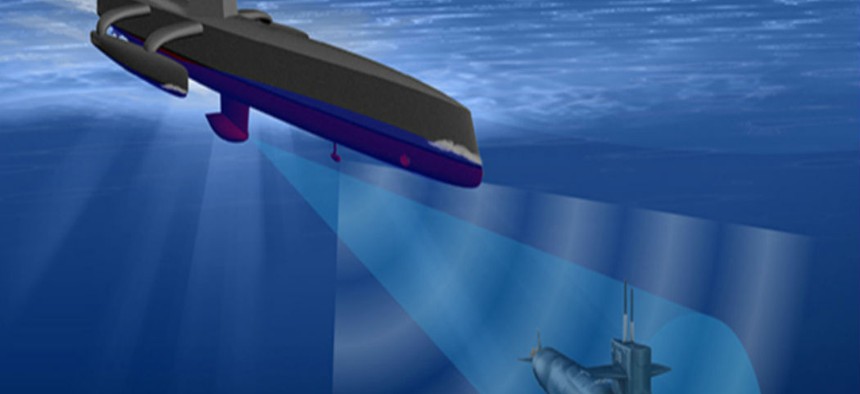Navy anti-submarine drone-ship conducts minehunting testing
The Navy’s latest anti-submarine unmanned surface vehicle is scheduled for operational testing with additional counter-mine and surveillance payloads.
The Navy’s next generation drone, the Class III Medium Displacement Unmanned Surface Vehicle (MDUSV), will be adopted by the Office of Naval Research (ONR) this summer and enter operational testing and evaluation for mine-countermeasure and electro-optical/infrared technology, as well as its diesel electric submarine detection capabilities.
According to Dr. Robert Brizzolara, Director of the project at ONR, the Sea Hunter program will be fully transferred to the ONR in the next few months.
Under ONR control, the Sea Hunter MDUSV is scheduled to be tested with mine-countermeasure technology by the summer and be installed with an electro-optical/infrared (EO/IR) sensor by fall. The sensor will enable long-range naval thermal imaging, use of infrared laser systems, and enhanced target detection, according to BAE Systems, the industry developer. Plans for FY2018 include adding intelligence, surveillance, and reconnaissance technology, and offensive anti-submarine payloads, which would extend the mission beyond surveillance.
The Sea Hunter is a purpose built drone, designed to be unmanned from the point of conception, and has a built-in compatibility with a Remote Supervisory Control Station (RSCS). The RSCS can be located either at sea or on shore, and will be able to remotely supervise the Sea Hunter, communicate new mission instructions to it, and, if necessary, exercise remote control over the vessel, according to Leidos executives.
It is 132 feet long and weighs 135 tons, with a range of up to 10,000 miles, according to an earlier Defense Systems report.
Notably, the Sea Hunter is a trimaran vessel, meaning that it has three hulls: one main one and two smaller hulls on either side, called outrigger hulls. The advantages of the trimaran design are that they provide increased stability without requiring a weighted keel, and the Sea Hunter is able to withstand waves of more than five feet. Trimarans also have higher capacity for linear trajectories, and can operate in shallower waters. However, the added hulls increase the ships width, thereby decreasing its maneuverability.
The Sea Hunter was originally developed by the Defense Advanced Research Projects Agency (DARPA) and was known as the Anti-Submarine Warfare Continuous Trail Unmanned Vessel (ACTUV). Though changing hands, the program goals remain the same: To build a naval surface drone that can fully execute all functions and carry out extended missions with minimal human supervision and equip it with tracking technology that can overtake the defensive advantage of almost-silent diesel electric submarines.
Rear Adm. Frank Drennan, Commander of the Naval Mine and Anti-Submarine Warfare Command, described detecting the electromagnetic and sound signature of a battery-powered, diesel-electric submarine as “like trying to identify the sound of a single car engine in the din of a major city.”
For this reason, Sea Hunter is equipped with an advanced radar that emits a high frequency signal, which uses a longer wavelength to identify vessels using stealth measures that would normally render them undetectable.
The sonar technology onboard the Sea Hunter is also designed to have minimal impact on marine life.
The MDUSV was christened “Sea Hunter” in April 2016, and has been undergoing Engineering Sea Tests since November 2016. It has been able to successfully complete a multi-waypoint mission with no human manipulation of course or speed, according to Leidos.
Further testing is currently underway off the coast of San Diego, California.




